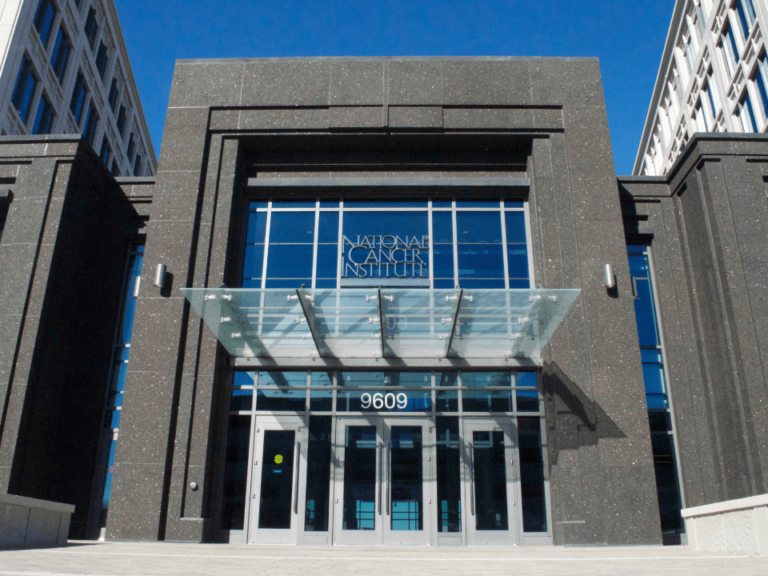I first heard something about a red sofa that cost an impressive amount of money soon after I started to cover the controversy at the Cancer Prevention and Research Institute of Texas.
The sofa, I was told, was to be purchased with MD Anderson funds for the office of Lynda Chin. I wanted to look into it, but I want to look into many things, and some take precedence over others. This seemed to be fun, but it was undeniably trivial.
The sofa in question was intended for the same entity CPRIT was being asked to fund. Had I been able to get it through my thick skull that the furniture was a part of the same story that was causing the ungluing of CPRIT, I would have filed my freedom of information requests sooner.
When it finally appeared, my friends referred to this story as “furnituregate.”
As the first lady and a senior scientist at MD Anderson Cancer Center, Lynda Chin built an executive suite intended to make corporate executives feel at home while hammering out co-development plans or negotiating agreements for licensing anticancer compounds.
Internal documents obtained by The Cancer Letter show that the suite may have cost the state institution at least $1.5 million, and the overall costs could be closer to $2 million.
MD Anderson officials disputed these numbers. Total spending on the lab and office design projects was $1,492,159 they said, but this sum also included lab equipment, such as new hoods and a ventilation system for a specialized chemistry section. Officials estimated the cost of upgrading Chin’s office suite at $547,434.
This explanation appeared to be contradicted by the budget documents, purchase orders, invoices and other materials obtained under the Texas Public Information Act. These documents do not mention lab equipment and contain no evidence of payments being made for such expenses from the budget for upgrading the suite.
I posted these documents—680 pages—on The Cancer Letter website.
Though architectural plans identify the project as “Dr. Chin Office Renovation,” a renovation it was not.
The 25,000-square-foot suite, much of it south-facing, was new, located on the sixth floor of the just-constructed South Campus Research Building III.
Chin, scientific director of the Institute for Applied Cancer Science and chair of the cancer center’s Department of Genomic Medicine, was its first occupant.
“Corporate” was the word MD Anderson documents used repeatedly to describe the intended feel of the suite—a departure from standard practice at MD Anderson, where office furniture styles tended toward heavy-duty functionalism and where and office space is strictly regimented in accordance with rank.
Since the suite isn’t open to the public, all but a few members of the faculty and staff ever saw it.
Many of the interior walls in the new suite were replaced with translucent interior glass panels, an upgrade that was estimated to cost $210,000 and required a variance from the UT System.
The bill for modern classic settees, lounge chairs and occasional tables for the institute’s two senior leaders came up to $27,920. In another departure from the norm, a credenza in the executive office conceals a refrigerator.
There was no donor specifically underwriting this project.
Purchase order by purchase order, the money came from MD Anderson’s capital accounts, documents showed.
The story of rising costs and reconfigurations in Chin’s suite did little to lift the spirits of MD Anderson faculty members, who were expected to work harder to offset the institution’s rising operating costs.
MD Anderson doctors who planned to attend the annual meeting of the American Society of Clinical Oncology in 2013 had to submit plans for making up the time missed in the clinic.
In a survey conducted earlier that year, faculty members characterized DePinho and Chin as “imperious” and “dictatorial.” In a recent memo to employees a bit before the ASCO annual meeting that year, DePinho announced austerity measures, which include suspending merit raises, slowing down recruitment—and suspending capital projects.
MD Anderson officials said the $547,434 they acknowledge having spent on the office portion of the project was “similar to previous renovations made to accommodate new senior faculty.”
Responding to questions, officials said that “the renovations of space for the Institute for Applied Cancer Science and Department of Genomic Medicine—both new entities for MD Anderson—transformed a traditional academic office suite to a work environment and meeting area for a science/business enterprise. “The existing space was not configured to support this new concept,” the statement reads. “The 9,000-square-foot office space was redesigned to create an open environment of communication, provide an appropriate meeting space with high-level industry decision makers and support a new suite in computational biology.”
Since the project fell outside MD Anderson’s rigid standards for allotting office space and furniture, officials ended up seeking variances from Kenneth Shine, the UT System’s executive vice chancellor for health affairs. Though insiders say that formal variances were granted, MD Anderson officials said no such documents existed.
“The variances were approved by Dr. Shine via email, and MD Anderson is not aware of any additional variances,” an official said to The Cancer Letter.
IACS appeared to be a crucial element of DePinho’s vision for MD Anderson. After all, DePinho and Chin were chosen to lead MD Anderson in part because of their relationship with the pharmaceutical and biotechnology industries and their promise to make the massive academic cancer center behave more like a corporation.
IACS was the place where discovery would meet commerce.
“It is intended to be a hybrid that brings the best of what academia has and the best of industry practice, merge them together to have this new construct that allows us to execute efficiently cancer drug discovery, but do so in a scientifically-driven manner embedded in the richness of academia,” Chin said as she described the institute in an MD Anderson video.
Documents show that the suite’s décor was intended to reflect perceptions of accoutrements the pharmaceutical industry executives would require.
For starters, Chin wanted to replace many of the interior walls with a translucent material produced by a company called DIRTT, an upgrade initially estimated at $180,000.
The rationale:
“The suite is dark and will benefit from natural light,” an MD Anderson official wrote in a request for a variance. “The glass walls also provide a feeling of transparency which fosters collaboration. The corporate feel is also enhanced by glass walls.”
Subsequently, another $30,000 worth of DIRTT panels was used, replacing the drywall partitions that separate Chin’s office from a small conference room. “Dr. Chin would like to add a glass wall and sliding door between her office and the conference room,” the variance request states.
This would further enhance the “corporate feel” by “giving a connection between her office and the conference room,” the variance request states. Giulio Draetta, director of IACS, also got a DIRTT wall. MD Anderson officials provided similar rationale for spending $50,000 more than the norm to buy two desks, two non-regulation freestanding credenzas, seating and glass-top tables for Chin’s and Draetta’s offices:
“Their office suites will be used by institute advisory board, leadership team, and joint steering committee and high level meetings and needs furniture that reflects the institute,” the variance request reads.
The DIRTT walls in Chin’s and Draetta’s offices are largely obscured by their high-top credenzas.
Do pharmaceutical company executives expect luxurious surroundings?
Do they judge cancer centers by the Bauhaus pieces scientists display in their offices?
Are luxurious offices standard in big pharma?
I called Bruce Ross, former chairman of the board of Biogen Idec, former senior executive at Bristol-Myers Squibb, and former CEO of the National Comprehensive Cancer Network.
No, no, and no, Bruce said. “It’s extraordinary to see this sort of opulence in the office suite of a senior scientist at an academic medical center, particularly one that is state-owned,” he continued. “It moves into the bizarre class, because the designer and occupant of these quarters is the wife of the president of the institution. I personally would feel very uncomfortable attending a meeting in such surroundings. The trend in corporate America today is to downsize and simplify executive offices and meeting facilities.”
I submitted several questions for Chin, but the institution chose to respond in a statement. The cancer center’s investment in the institute has paid off, the statement read.
The institute “has generated a research collaboration and license agreement with GlaxoSmithKline that is estimated to have a potential value of $335 million,” officials said.
“In addition, IACS/GM has raised more than $15 million in philanthropy,” officials said. “In total, IACS/GM activities have led to more than a dozen publications in leading journals.
“We believe our investment in the Institute for Applied Cancer Science and the Department of Genomic Medicine has created a world-class facility and teams that will yield benefits for patients at MD Anderson and beyond for years to come,” officials said. “The MD Anderson mission is to eradicate cancer, and the work ongoing in this facility will help achieve that goal.”
Spending on executive offices is a recipe for disaster in an academic institution, public or private, said Arthur Caplan, head of the Division of Medical Ethics at NYU Langone Medical Center.
“At a time of budget cuts, sequesters and cutbacks in research funding, opulent spending on space, facilities and furnishings seems at best ill-thought through and at worst callous to budget realities,” Caplan said. “In my experience, lavish spending on non-scientific space and furnishings is the ‘third rail’ for administrators.”
Donors may not be pleased, either, said Sheldon Krimsky, the Lenore Stern Professor of Humanities and Social Sciences and adjunct professor at the Department of Public Health and Family Medicine at Tufts University.
“At a time of federal sequestration and forced furloughs of dedicated public employees, the extravagance of spending at MD Anderson, a public institution, seems unconscionable,” said Krimsky, co-author of “Biotechnology in Our Lives,” a recently published book.
“How would those volunteers and small donors who have never seen the profligate executive suites feel about the use of their contributions?”
MD Anderson documents showed that the office upgrade project began soon after she and DePinho arrived at the institution and was completed in the spring of 2011.
Sources said that the just-constructed office suite didn’t require much improvement. The walls were up. Carpets were down. Light switches, plumbing and climate control functioned fine.
Raymond DuBois, the MD Anderson provost at the time, balked at issuing the initial variances. Instead, he kicked the matter to Shine, who is ultimately responsible for managing DePinho’s and Chin’s conflicts of interest.
DuBois was the middle link in a chain of command that was like no other: Chin had to go to DuBois when she needed institutional resources, while DuBois reported to Chin’s husband.
One didn’t need to be an insider to see that the couple didn’t trust DuBois, whose job as provost was to promote the academic mission of MD Anderson.
On Oct. 24, 2011, DuBois fired off an email to Shine:
“I am inclined to approve these variances for Dr. Lynda Chin, but wanted to make sure that you were in the loop on these requests. These are requests that are outside our normal guidelines, but some of these I think will help the institute be more competitive and provide better space for industry/academic collaborations.”
An inclination to approve does not an approval make. It means nothing. The email says fundamentally: Here is some expensive stuff. You approve it.
And Shine approved. On Oct. 25, he responded with a two-word email:
“Approved. Ken.”
“It is not uncommon for MD Anderson to seek variances to renovate work spaces, offices and laboratories of new senior faculty recruited to the institution,” MD Anderson officials said in response to questions from The Cancer Letter.
Altogether, the following variances were sought:
- Glass walls: $180,000. “The suite is dark and will benefit from natural light,” the variance request reads. “The glass walls also provide a feeling of transparency which fosters collaboration. The corporate feel is also enhanced by glass walls.”
- More glass walls and a glass sliding door: $30,000. “Replace existing standard dry wall along South wall office corridor and interior entrance suite with glass walls has been previously approved,” a variance request states. “However, Dr. Chin would like to add a glass wall and sliding door between her office and the conference room.” The justification asserts that this would further enhance the “corporate feel” by “giving a connection between her office and the conference room.”
- Free-standing desks with credenzas and seating with glass end tables and coffee tables for Chin’s and Draetta’s office suites: $50,000. “Their office suites will be used by institute executive advisory board, leadership team, and joint steering committee at high level meetings and needs furniture that reflects the institute,” a request states.
- Build executive boardroom “with a corporate feel” that would include “one large conference table to accommodate 15-20 people” and “full audio-visual capabilities, including teleconferencing:” $147,800. This is necessary because “the boardroom will be used for the institute executive advisory board, leadership team, joint steering committee and VIP meetings,” the justification reads.
- A boardroom table that has power and telecommunications capabilities: $14,700. “The boardroom will be used for institute executive advisory board, leadership team, and joint steering committee and VIP meetings and needs a table with tele/data capabilities that can house microphones for videoconferencing needs,” the request states.
- Cushion-top seating and storage spaces in open environments, in the area occupied by post-docs and computation staff: $34,906. “These spaces don’t have sufficient space for additional folding chairs or lateral file cabinets,” the request states. “The cushion-top pedestal can be used as additional storage and seating, and can be stored under desk, providing ample room for working.”
- Glass panels for partitions in computational area: $400 per partition. “This is the computational area and furniture needs to be open, but semi-private environment since they work at their desk the majority of the day,” the justification reads. “They also want to foster collaboration between workstations, so frosted panels will give privacy, but openness as well.”
- Wood veneer for partition panels: $60,000. The veneer accents would be on the lower sections of partition panels (as opposed to standard fabric panels). The rationale: “Wood panels will add accents to the space since these are research faculty working in open environment.”
DuBois, who resigned from MD Anderson in August 2012, declined to discuss the project.
“I am no longer employed by MD Anderson and cannot comment on specific purchasing decisions or office renovation practices,” he said at the time. “All such questions should be directed to Dr. Kenneth Shine, to whom Dr. Chin reported, and who had the ultimate authority over approval of purchases and provision of resources, including office space.”
An official tally called the Funding Authorization Transmittal, reports the project’s total cost at $1,542,802—almost 60 percent above the original budget of $919,200.
This amounts to $61.71 per square foot, though most of the high-priced items are concentrated in the executive section of the suite, documents show.
Construction costs came up to $905,000. Furniture cost reflected in the budget added up to $175,000. (The original estimate was $100,000.)
MD Anderson officials said budgets can be misinterpreted. “The Funding Authorization Transmittal is a high-level estimate that gives staff a starting point for budgeting,” officials said.
“Figures for line-item components frequently change as the project becomes more defined, but MD Anderson manages the project to the overall bottom line. Line items should not be considered as a true baseline for budget comparisons.”
Just adding up the invoices suggests that the actual furniture bill was $464,306, though this appears to include furnishing the institute’s facilities on the fifth floor of the same building.
Overall, furniture chosen for the suite tends toward darker, reddish hues.
The table in the big conference room is a 20-foot “Saber,” produced by a company called Nucraft. (Purchasing price: $12,151).
The two credenzas in the suite cost $4,743 and $5,141. One of them conceals a refrigerator ($2,704).
In their offices, Chin and Draetta gravitated toward modern classics. Chin chose a red leather Florence Knoll settee with a polished chrome base ($7,755) and a matching lounge chair ($5,012). Draetta chose the same group, but in black ($6,961 for the settee, $4,481 for the lounge.)
Other classic pieces in the executive suites include a Ludwig Mies van der Rohe clear glass MR table ($1,669), a Florence Knoll coffee table ($604), a Knoll end table ($583) and Marcel Breuer coffee and side tables ($500 and $353).
Data processing and communications equipment was originally estimated at $10,000, but ultimately came up to $160,000 in the budget. When the invoices are added up, the IT spending rises to $282,522.
Experts said the IT purchases are standard equipment for high-speed data throughput.
With additional furniture and IT equipment added to the FAT, the cost of the project jumps to $1,954,630.
On Sept. 9, 2011, when the project was getting set up in the MD Anderson bill-paying system, an official suggested that it should be treated as an “unbudgeted ‘high priority’ space renovation request” funded from the provost’s budget for space renovation.
However, officials determined to tap capital funds instead, and documents show that a large number of such funds were charged as the office was being built. MD Anderson officials confirmed that long-term capital project funds were used. Such funds are “derived from investment income, philanthropy and patient revenue,” officials said in a statement.
The project’s growing price appears to reflect its expanding scope.
Records show two “change orders,” the result of the client saying that the job was performed well enough, but changes need to be made anyway. A change order, essentially a change of mind, is an unusual occurrence in state construction projects.
The first change order, dated April 13, 2012, cost MD Anderson $98,276.33. “This change order includes the additional electrical scope developed after the furniture and boardroom plan was developed,” an explanation reads. “The funds are also needed for additional scope including millwork, dishwasher, and fire safety.”
The second change order, on May 22, 2012, cost $55,489.22. It included “fire alarm, electrical, HVAC, architectural, furniture wall system, teleshades due to office and boardroom reconfiguration,” the explanation reads. “Plumbing changes due to unforeseen conditions when installing the dishwasher. Relocation of sprinkler heads due to reconfiguration of office space. Modification of the door to except [sic] the card reader.”
As costs increased, officials started to wonder whether Shine needed to be consulted again.
In October 2011, when several officials raised questions about the need for additional variances, Chris McKee, associate vice president, business affairs, cut off the debate:
“It is our understanding that these approvals fall into operational decisions category that Dr. Shine gave the campus authority to manage when he approved the overall business plan,” he wrote in an email.
Soon after The Cancer Letter published the Furnituregate story, Draetta, the gentleman with the black Florence Knoll suite, clarified to senior MD Anderson senior faculty members that he and Lynda deserved good furniture because they were from Harvard.
The email was forwarded to me minutes after Draetta hit send:
Lynda and I were both extremely concerned about moving to Texas, having never lived here and being heavily influenced by the Harvard community.
The administration then, Dr Shine, Dr DuBois, put together attractive recruitment packages and Lynda and I negotiated for the best deals we could get: salaries, infrastructure, office space. Lynda took the lead in negotiating as the new department chair.
We had beautiful offices at Dana Farber, which we had just moved into. We asked for offices that resembled those we had in Boston and we got them. Never knew that we had broken any rules.
Lynda and I are bringing here exactly what many of you have been asking for: expertise in genomic science and translation. Every one of the flagships projects asks
for expanded “omics” capabilities and drug discovery and development efforts. We are here for this and with your support will achieve this.
Thanks very much,
Giulio
Later, the Houston Chronicle columnist Lisa Falkenberg wrote a hilarious piece about MD Anderson’s new-found appreciation of finer things. The headline was a hoot: “Are $7,700 Couches Needed to Cure Cancer?”
“Rest assured, donors and patients, your money was well-spent,” Falkenberg wrote. “It’s important to point out that…Dr. Giulio Draetta, director of the institute…fully explained his reasons for wanting a nice office in a letter he wrote to friends and colleagues that was obtained by the Chronicle.
“’Lynda and I were both extremely concerned about moving to Texas, having never lived here and being heavily influenced by the Harvard community,’ he wrote. “Bless his heart. He thought we’d set him up with trailer curtains and an outhouse. We can’t expect a Harvard recruit to slum at a state-funded nonprofit hospital without offering him a little incentive.”
On April 6, 2015, Chin vacated her jobs as founding head of genomic medicine and IACS scientific director to join the UT System as an associate vice chancellor for health transformation and chief innovation officer for health affairs.
In her new UT System role, Chin would create and lead the new Institute for Health Transformation that will seek to “leverage, develop and deploy innovative, technology-enabled solutions to improve access to and affordability of quality health care,” officials said.
“If we want to transform the way health care is delivered, then we need bold and innovative solutions,” UT System Chancellor McRaven said in a statement. “Dr. Chin is a very talented physician scientist who has the vision and the ability to get it done.”
McRaven made it his top priority to fix the morale problems at MD Anderson. On a visit to MD Anderson a month before change was announced he declared that trust at the cancer center had been broken and called for shared governance at the institution. This new structure is being implemented.
The UT System said its new Institute for Health Transformation initially will focus on Project DOC, for Diabetes Obesity Control, which was funded by the Board of Regents in 2014 to improve diabetes care and management in South Texas through the use of big data and technology.
“The current health care model is based on providing acute care to sick patients; that is very ineffective in management of chronic diseases like diabetes,” Chin said in a statement. “A system re-design is needed. Today’s social, mobile and cloud technology along with big data and cognitive analytics can be the keys to a much-needed transformation.”
UT System officials said to the Houston Chronicle that Chin had been working on the diabetes issues since last year. In June, she was named a health fellow on the project, which received the first-phase funding of $5 million in November 2014.
Chin’s departure eliminated even appearances of conflict, potentially strengthening DePinho’s position as MD Anderson’s president. MD Anderson scientist Andrew Futreal became chair ad interim for Genomic Medicine.
The day before Chin’s departure from MD Anderson was announced, the Houston Chronicle ran the following editorial:
Early detection of a problem can often prevent the spread of cancer, at least according to the physicians at the crown jewel of the Texas Medical Center, the University of Texas M.D. Anderson Cancer Center…
The one dangerous symptom that shouldn’t be ignored is faculty dissatisfaction. The faculty has spoken in four negative surveys as well as in a recent faculty senate resolution sent to UT System leaders, where members cited a ‘climate of fear’ and ‘pervasive dissatisfaction’ at M.D. Anderson…
Lives are at stake in the important work done at M.D. Anderson. The chancellor and the board of regents should treat this management problem with the same urgency as physicians do when treating their patients.
In a recent interview, I asked Dan Fontaine, MD Anderson’s executive chief of staff, whether Chin has been replaced at IACS.
“I don’t think that position has been replaced, and the reason is she moved and spent a whole lot more of her time in the digital world, with IBM and Watson technology,” he said. “Frankly, I think, it’s not to say that Lynda wasn’t an important contributor from a scientific standpoint at the inception, but Giulio Draetta and the other folks that he brought on board with [IACS] are making great progress.
“I’m not sure there’s a specific scientific director anymore, because they’re getting a lot of their scientific direction both from the work that we’re doing for other platforms for the Moon Shots, as well as from our own faculty, having worked with them on the development of certain things. To my knowledge, the scientific director for IACS I do not believe has been refilled.
I asked whether any plans are afoot to refill the position.
“I don’t know that it’s actively under recruitment,” Fontaine said. “I think how things evolved with Giulio and the rest of the scientific team there, I think that a lot of the work that they’re doing is with other scientific leaders on some of our moon shots and some of our platforms.
“But generally I think Giulio and the rest of the team there is basically kind of doing it themselves.”
I asked Fontaine to explain the metrics of IACS’s performance.
“I think we’ve got some pretty pleasing ones,” he said. “It’s interesting because IACS was able to shift from small molecules to some small molecules and immunotherapeutics. And there were some things that were here when IACS was being formulated that they were doing work on and it definitely accelerated it.
“I think we’ve got one of our first ones that are either in clinical trials or on the verge of starting in phase I clinical trials that came out of one of our inventions here.
“I think that also because with a lot of these biologicals, it’s also pairing them with other things. And it’s opened opportunities to pair some of the things that we’ve done with other drug companies’ products. Some of this is proprietary, so I’m not going to be able to go into much more detail.
“But I think if you look at the alliances we’ve built with industry some of the things that are coming through the developmental pipeline with the institute for applied cancer science, some of the credence of the science that is coming out of here is given, and the discoveries that are coming out of here are given and the opportunities to join those things with what pharma is doing I think speaks very well for the [IACS].
“This isn’t just me saying this, I think that there’s never been this degree of outside external advisory input that’s been provided by people from other institutions, and it has been consistently bullish on what we’re trying to do here.
“That’s the subject of a different story.”












